VESUVIUS BLOWS
Two thousand years ago, the prosperous cities of Pompeii and Herculaneum thrived near Rome, 10 miles from the foot of the volcano Mount Vesuvius. Vesuvius hadn’t exploded for over 1,000 years; no one even knew it was a volcano. Then on August 24 in the year 79 A.D., it erupted, completely burying both cities under mountains of ash-Pompeii and Herculaneum were lost.Mount Vesuvius continued to erupt sporadically over the centuries that followed, each time adding to the volcanic debris that covered the former town sites; each layer leaving the two cities more hidden than before. Four hundred years later, the Roman Empire collapsed, and legends about the two cities went with it. For 15 centuries, they lay forgotten and undisturbed, their stories untold. Then clues about their existence began to turn up. For example, around 1594, a Roman architect named Domenico Fontana was digging a canal to supply water to a rich man’s home when workmen uncovered pieces of ruined buildings and a few ancient coins. But nothing much came of the discovery.
RUMORS OF TREASURE
In 1707 part of Italy came under Austrian rule, and Prince d’Elboeuf came to command the cavalry. He heard rumors of treasures being brought up from underground, so he promptly purchased a large parcel of land in the immediate vicinity. Over the next 30 year, he had shafts and tunnels dug and uncovered vases, statues, and even a number of polished marble slabs-once the floor of the theater in Herculaneum-all of which he used to decorate his villa.Word of the prince’s finds spread, and other treasure hunters came looking. When the first skeleton-complete with bronze and silver coins-was unearthed in 1748, treasure fever hit hard. For the next several years, artifacts were continually looted from the area. But it wasn’t until 1763, when workers unearthed an inscription reading “res publica Pompeianorum“-meaning “the commonwealth of Pompeians”-that the ancient city was identified.
SAVED AT LAST
The looting of Pompeii and Herculaneum continued for 100 years until a new ruler, King Victor Emmanuel II, became interested in preserving the sites. In 1860 he put archaeologist Giuseppe Fiorelli in charge of excavations. From that time until the present, the treasures of Pompeii have been treated with the respect they deserve, and in turn, they have taught much about daily life in ancient times.Ironically, the explosion of Vesuvius occurred the day after the celebration of Volcanalia, festival of the Roman god of volcanic fire. When Vesuvius began quaking, spouting ash, and spewing rivers of lava on August 23rd, 79 A.D., most of Pompeii’s 20,000 inhabitants fled the area. For the next 12 hours, ash and pumice rained down on the town, accumulating at the rate of six inches per hour. About 2,000 people remained in the city. Perhaps they refused to abandon their treasures. Or possibly they were slaves ordered to stay behind. Early in the morning of August 24th, Vesuvius really blew its top. By then, it was too late.
GHOSTS
Crouching, crawling, and clinging to loved ones, the people were buried by ash, which perfectly preserved their positions at the moment of death. When rain came, the layer of ash turned to concrete, entombing the bodies in an undisturbed environment. The bodies themselves then slowly decayed. When archaeologist Fiorelli found the hollow cavities where the bodies had once been, he realized that by pumping wet plaster into what were essentially molds and letting it harden, he could make perfect casts of the dead.A beggar with a new pair of shoes died at the city gate. Perhaps he had recently swiped the shoes from a corpse. The owners of a house were hiding their valuables in a well when they fell in and died. A dog was still chained to a fence. A woman held an infant in her arms while two young girls clung to the hem of her dress. A man was trying to pull a goat by its halter outside the city wall. Thirty-four people were hiding in a wine vault with food that they never got a chance to eat.
A man, seeking refuge in a tree, died holding a branch. A young girl clutched a statue of a goddess. A man, laying next to a woman seven months pregnant, reached out to cover her face with his robe in the moment before death. A group of priests were about to sit down to a meal of eggs and fish. One of the priests had a hatchet and chopped his way from room to room as lava rushed after him. He was trapped in the last room, which had walls too thick to chop through. The remains of a woman were found next to a wine vat. Inside the vat were over 100 silver dishes and 1,000 pieces of gold. One of the silver cups bore this inscription: Enjoy life while you have it, for tomorrow is uncertain.
CIVILIZATION INTACT
Here was an entire thriving city, caught exactly at the peak of its prosperity and perfectly preserved: eggs unbroken; bread baking in the oven; coins left on a countertop. Pots on cookstoves still contained meat bones. Shops displayed onions, beans, olives, nuts, and figs. A heap of discarded fish scales was uncovered near a fish shop. A meal of bread, salad, cakes, and fruit was set on a table. Ropes and nets used by unknown fishermen were preserved, as was the straw padding recently removed from a shipment of glasswares.Papyrus scrolls, charred but still readable, revealed dissertations on music and other subjects. There were taverns, snack shops, gambling halls, a stadium that could hold 20,000 spectators, theaters, public baths, streets with sewer systems and raised sidewalks, homes with plumbing, and thousands of works of art. Everyday objects such as perfume bottles and glass jars, sewing needles and brooms, muffin pans and cooking pots were found in the homes. Also uncovered: glass vases, tile mosaics, painted murals, marble statues, golden jewelry, bronze lanterns, jeweled amulets, religious icons, and exquisite furniture.
POMPEII TODAY
The excavation of Pompeii continues today-it’s estimated that only about a third of the town has been uncovered. Yet Vesuvius continues to rumble, most recently erupting in 1944.Will it bury Pompeii again?

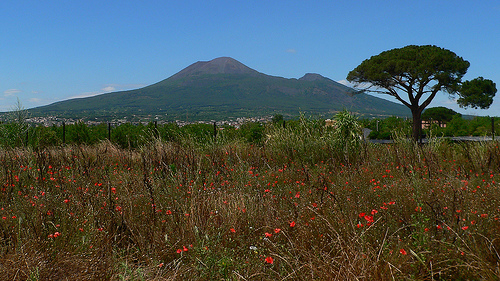
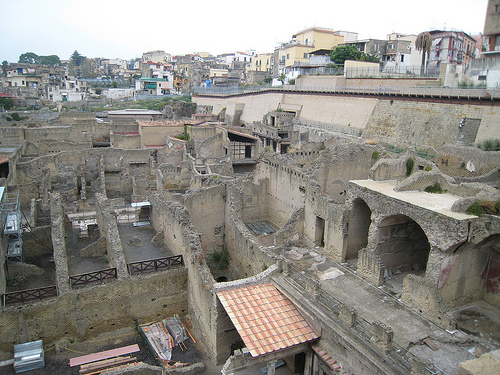
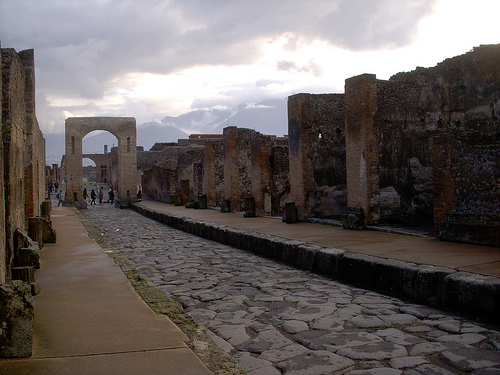
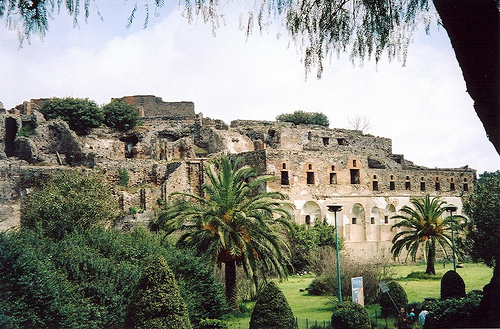
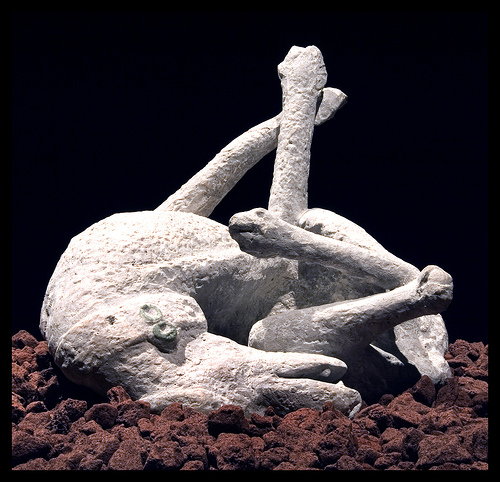
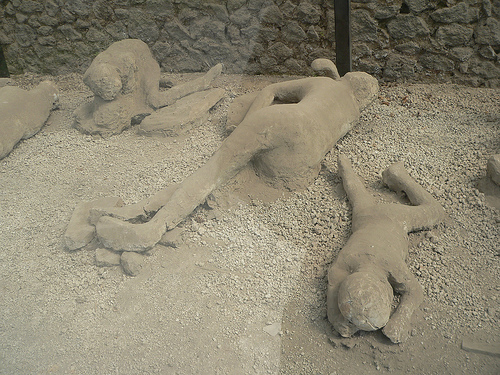
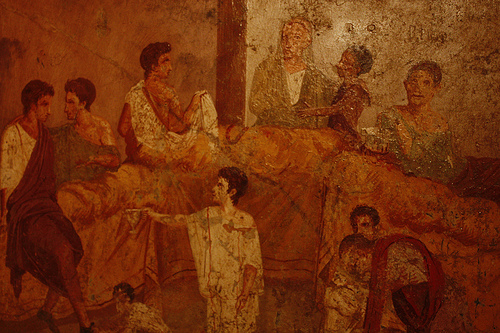
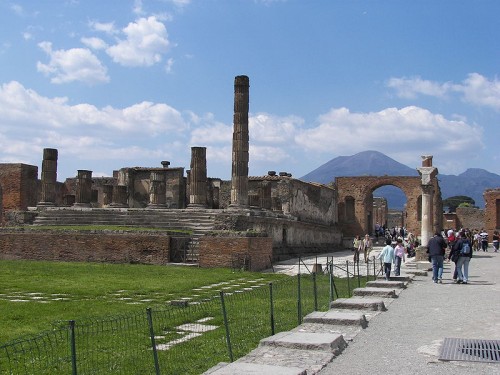
No comments:
Post a Comment